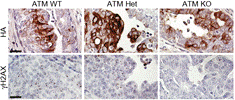Veterinary and Biomedical Sciences, Department of
Date of this Version
2011
Document Type
Article
Citation
Published in Journal of Immunological Methods 372:1–2 (2011), pp. 107–118 doi: 10.1016/j.jim.2011.07.004
Abstract
A/J mice bearing the H-2 allele IAk are highly susceptible to autoimmune myocarditis induced with cardiac myosin heavy chain (Myhc)-α 334–352, whereas B10.A mice carrying a similar allele IAk are relatively resistant, suggesting that the generation of Myhc-α-reactive T cell repertoires is influenced by genetic background. To enumerate the precursor frequencies of Myhc-α-specific CD4 T cells, we sought to create IAk tetramers for Myhc-α 334–352. Tetramers were created using approaches that involve covalent tethering of individual peptide sequences or exogenous loading of peptides into empty IAk molecules by peptide-exchange reaction. Using ribonuclease 43– 56 tetramers as controls, we demonstrated that by flow cytometry (FC), Myhc-α 334–352 tetramers specifically bind myosin-reactive T cells. CD4 cells isolated from A/J mice immunized with Myhc-α 334–352 were used to optimize conditions for tetramer staining, and neuraminidase treatment prior to tetramer staining permitted the detection of Myhc-α-specific cells ex vivo. The reagents are useful tools for monitoring the frequency of Myhc-α- reactive CD4 cells and to determine their pathogenic potential at a single cell level by FC.


Comments
Copyright © 2011 Elsevier B.V. Used by permission.